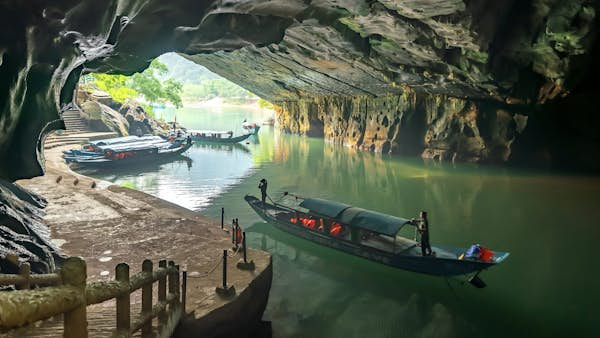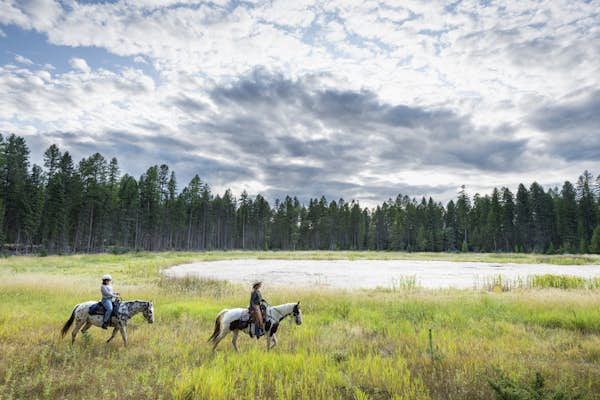


A first-time guide to Vietnam
Gone is the era when Vietnam evoked only images of rice fields, floating markets and conical-hat-wearing workers. This Southeast Asian powerhouse has today become a destination known for majestic natural beauty, pristine beaches, unexplored ecological reserves and delectable cuisines.
Halong Bay, Hoi An’s Old Town, Phong Nha – Ke Bang National Park and other Vietnamese sites have joined the UNESCO World Heritage roster. Staple Vietnamese foods like banh mi and pho are common enough to appear in English-language dictionaries. Some of the most discerning travelers in the world are ranking Phu Quoc with the Maldives and Bali on lists of the world’s most beautiful islands.
And that’s only the beginning of what this country has to offer.

The best time to visit Vietnam
Vietnam is nearly 1650km (1025 miles) from north to south – a length that ensures weather patterns vary widely, and that the best time to visit depends very much on your planned destinations and personal preferences. Most visitors will want to avoid the stormy season, especially in Northern Vietnam and Central Vietnam, as violent rainstorms often lead to flash floods, mudslides and road closures. In contrast, the southern storm season (June to November), while inconvenient, does not pose nearly as significant a risk to travelers.
The storm season starts from May and ends around October in the north; from September to December in the central coastal regions; and from May to August in the central highland regions.
Other than that, the country climate is separated into three general zones:
- In North Vietnam (Hanoi, Sapa, Ha Giang, Halong Bay) in September and November or March and April, the weather is cool and dry and the local tourism sector is not overwhelmed by intra-Vietnamese travel. August and September are also Sapa’s harvest season and the best time to highland hills in vibrant bloom.
- Central Vietnam (Hoi An, Nha Trang, Hue, Danang) is best visited from April to August, when you’ll avoid the worst of the storm and flood season and abundant sunshine will help you make the most of the white-sand beaches around Hoi An and Nha Trang.
- We recommend visiting South Vietnam (Ho Chi Minh City, Mekong Delta, Phu Quoc) from October to April, after plentiful rains from the prior months ensure the rivers and channels of the Mekong Delta are abundantly fed, allowing for smooth travel through this maze of crisscrossing waterways.
We’d recommend avoiding visits during major holidays like Tet (the Vietnamese New Year, usually in late January or early February) due to soaring prices and booked-out accommodations.

How much time should I spend in Vietnam?
To experience the full breadth of experiences here? Months. Acknowledging that’s unlikely for most visitors, two weeks will get you through most of Vietnam’s best-known destinations.
Starting from either Hanoi or Ho Chi Minh City (HCMC), you can travel the length of the country and enjoy a wealth of sights, tastes and experiences. Must-visit places include iconic favorites Sapa and Halong Bay; cultural and historical hot spots such as Hoi An and Hue; river capitals like Can Tho and the sprawling Mekong Delta that surrounds it; and the tropical island paradise of Phu Quoc.
If you’re short on time or money, quick trips of three to four days focusing on a singular area or city like Hanoi, Ho Chi Minh City or Phu Quoc are feasible and offer a satisfying taste of Vietnam’s attractions.
Getting around Vietnam
Vietnam has three major international airports, in Hanoi, Ho Chi Minh City and Danang (the gateway to Hoi An and Hue). In addition, Phu Quoc Island has its own international airport with direct flights to Singapore, Shanghai, Cambodia and Laos – and the airport at Phan Thiet will launch international flights in 2025.
Traveling within Vietnam itself is relatively easy and affordable, with options including trains, buses and domestic flights. Flights are the most convenient and speedy way to travel within the country. Buses are affordable, reach almost everywhere in the country and offer sleeper options for those who want to get between north and south without stopping overnight. In recent years, renewed interest has led to a few train lines being refurbished and revitalized. These days, traveling by train is a great option for those who want to take their time enjoying the scenic routes across the country.
Within cities, cabs, rideshare apps like Grab or Be, and traditional motorbike taxis are easily accessible. For those with the stomach for chaotic traffic, most Vietnamese cities are walkable and a lot of fun to explore on foot – although the tropical heat and humidity coupled with urban city dust and exhaust can make walking long distances unpleasant.

Top things to do in Vietnam
All the thrilling things you can do in Vietnam could never fit all on one list. Yet first-time visitors won’t want to pass up a few key experiences.
Cruise Halong Bay. This stunning UNESCO World Heritage Site comprises nearly 2000 towering limestone islands in a massive blue-water bay. An overnight cruise is the best way to take it all in. If you happen to have some extra time, Lan Ha Bay is to the south of Halong: it’s no less beautiful but much less traveled.
Explore Hoi An. With its lantern-lit streets and turbo-speed tailor shops, this ancient town seems frozen in time. In the countryside surrounding the town, a plethora of traditional craft villages await to be explored.
Climb down the Cu Chi Tunnels. This warren of war-era tunnels is already a heart-stopping experience – and as of early 2024, night tours have been offered to travelers with nerves of steel and a taste for reliving wartime thrills.
Hike the highland trails of Sapa. The Northwest Highlands are famous for majestic trails and stunning natural beauty. Sapa serves as the landing pad and base camp for adventurous trekkers looking to explore the rugged region on foot.
Wander the Old Quarter of Hanoi. Get lost in this maze of narrow streets, each named after the goods once sold here. It’s a great place to experience Vietnamese street culture and food.

My favorite thing to do in Vietnam
My favorite thing about Vietnam? The food.
Beyond pho and banh mi, you can slurp up more than 200 distinct noodle dishes from every corner of Vietnam. There are foods unique to a single town. There are herbs unique to a certain patch of a single forest. There are cuisines designed to suit the palates of emperors past. There are simple and humble, cheap and hearty dishes meant to fill peasants’ stomachs.
There’s much to learn about the history of Vietnam and its people through the food they cook to nurture each other. My low-key dream is to travel to every town in Vietnam and try its specialty dish – and hear the backstory behind it. (There’s almost always some wacky story attached to a hometown favorite.) That would make quite a book.
How much money do I need for Vietnam?
While you’ll find luxury resorts, world-class dining and premium experiences in certain parts of Vietnam, the country retains its well-earned reputation for budget travel.
- Hostel room: US$10–15
- Basic room for two: US$10–40
- Self-catering apartment (including Airbnb): US$20–50
- Local bus ticket: US$0.20–1
- Coffee: US$1–3
- Banh mi: US$1–3 (note that the famous and drama-filled Madam Huynh Banh Mi in HCMC charges $3 per sandwich – and one can easily feed two regular adults or one starving weightlifter)
- Dinner for two in a local sit-down restaurant: US$10–30
- Beer: US$1–2 per can; $3 per liter of draft beer at a local beer hall

More tips for enjoying Vietnam
Bring lots of layers, no matter the season
Especially if you are traveling the length of Vietnam. The country’s climate varies greatly within short distances, so packing for different temperatures and weather conditions is the prudent thing to do.
Respect local customs and etiquette
As in other Asian nations, the Vietnamese value politeness and respect. When visiting temples, remember to dress modestly, and always remove shoes when entering someone’s home.
Stay away from tap water, and choose your street foods carefully
Tap water in Vietnam is not safe to drink, so stick to bottled water everywhere. Enjoying street food is an essential Vietnamese experience – but since food hygiene can be an issue, observe the locals and choose the street vendors they favor.
Prepare for chaotic traffic
The joke in Ho Chi Minh City and Hanoi is that traffic laws are more like suggestions, so be cautious when crossing streets and only consider renting motorbikes if you are an experienced driver.
A few words in Vietnamese go a long way
You can expect English to be fairly widely spoken in Vietnam, especially in big cities. Still, learning a few basic phrases in Vietnamese can only help – and will likely go a long way in demonstrating respect to and forming connections with locals.

The 18 best things to do in Houston
Houston is a massive metropolis – the fourth largest in the United States – which has drawn people from all over the world for its rich music, food, and business offerings. But don’t let Houston’s size fool you, it isn’t all hustle and bustle. The city maintains a diverse, down-to-earth and inclusive vibe with all sorts of cultural, scientific and outdoor offerings throughout H-town. These are 18 of the best things to do in Houston.

1. Visit the Houston Space Center
When Neil Armstrong set foot on the moon on July 20, 1969, he said, “Houston, the Eagle has landed.” He was referring to the on-site staff of the NASA Johnson Space Center here in H-town. Today, you can go where history was made and learn all about the moon landing and humanity’s exploration of space with a visit to Space Center Houston. The official visitor center of the NASA Johnson Space Center welcomes 1.25 million visitors each year who come to marvel at the largest collection of spacesuits and Moon rocks in the world there are over 400 space artifacts here in Houston.
2. Explore neighborhood-specific cuisines
Houston is one of the most ethnically diverse cities in the United States, and its food scene reflects that distinction. Taste your way through 70 different countries and US regions at some 10,000 restaurants in the Houston metro. Foodies will love eating their way through Houston’s diverse neighborhoods. For instance, you’ll find great Korean food in Spring Branch, fabulous Chinese in Chinatown, Vietnamese in Midtown, and the best Venezuelan food in Katy. Starting in the autumn of 2021, you’ll be able to experience POST Houston, a huge food hall with live music and event spaces that will showcase Houston’s culinary scene.

3. Walk the Museum District
Culture buffs should make their way to the Houston Museum District which is home to 19 different institutions. To make things easier for travelers, the Museum District has been separated into four different walkable zones. In the first zone, you can dive into a collection of 17,000 paintings, sculptures and rare books at the Menil Collection before walking to the Houston Center for Photography.
The second zone hosts the most museums, including the likes of the Holocaust Museum Houston and Houston Museum of African American Culture. The Contemporary Arts Museum and the Museum of Fine Arts are grouped in the third zone, while the Children’s Museum of Houston, Houston Zoo and The Health Museum are just a glimpse of what you can discover in the fourth zone of the Museum District.
4. Experience the Houston Livestock Show & Rodeo
Texas has its cowboy reputation, and you can experience a taste of that culture for yourself at the Houston Livestock Show & Rodeo. This rodeo, which has been around since 1932, is held over a couple of weeks in February and March and is known for having the world’s largest livestock show.
Watch cowboys wrangle steers and cowgirls whip around barrels on their horses during the rodeo, before playing games at the carnival, shopping among local wares, tasting delicious food at barbecue competitions and watching live concerts from some of the biggest names in music. Keep an eye out for special days of celebration and performances, like Tejano Day and Black Heritage Day.

5. Choose your own adventure, with 580 parks
Houston has 580 parks that comprise 66,000 acres of land, making this urban destination a great place for outdoor lovers. Not only can you play outside, you can get a different perspective on H-town. See the Houston skyline from the water, for example, on a kayak adventure with Bayou City Adventures. They’ll take you on the 53-mile Buffalo Bayou which runs through the popular Buffalo Bayou Park, which has 15 miles of biking and walking trails and public art.
6. See a ball game
The city of Houston has a lot of pride for their hometown sports teams and welcomes visitors to join in on the fun. Head downtown to watch the Houston Astros hit home run after home run or to cheer on the Houston Rockets as they dominate the court at the Toyota Center. Soccer fans have the option of watching the Houston Dynamo or the Houston Dash, men and women’s respective professional soccer teams, while football fans won’t want to miss a chance to see the Houston Texans take on opponents of the AFC South division. Rugby is just now growing in popularity in the United States, but Houston is well ahead of other big cities with their own professional rugby team called the Houston SaberCats.

7. See the Waugh Bridge Bats year-round
Austin doesn’t have a monopoly on bat colonies that spice up summer sunsets. Make your way to Waugh Bridge to see some 250,000 Mexican free-tailed bats fly out at dusk. Unlike Austin’s Congress Avenue Bridge bat colony, Houston’s bats live here full-time, s0 you aren’t limited to seeing them during any particular season. You can view them from the Waugh Bridge itself, or across the way as they fly into Buffalo Bayou looking for dinner.
8. Spend the day at the beach
Although Houston doesn’t technically have a beach, it only takes up to an hour’s drive to enjoy the Gulf of Mexico. At 26.2 miles from downtown Houston, Sylvan Beach Park is the closest beach. It’s known as one of the better places to swim because of its lack of seaweed.
If you want to skip the crowds of Sylvan Beach Park, make your way to the charming and quiet El Jardin Beach. You won’t mind driving the hour to Surfside Beach, as it’s known for its beauty and laid-back atmosphere. That said, you won’t find a lot of amenities here so pack an ice chest and bring snacks before you hit the road.

9. Try extreme sports
For Texas-sized thrills, ride the bowls of the 30,000-square-foot Lee and Joe Jamail Skatepark or catch some air wakeboarding at the full-scale cable wakeboarding park, Wake Nation. You can also try indoor or outdoor skydiving at iFly Houston and Skydive Spaceland, respectively, hit the Texas Rock Gym, or give the prairie single track a turn at Jack Brooks Park‘s mountain biking trails. You can even try gliding over the Houston landscape with the Greater Houston Soaring Association, who practice a motorless style of flight.
10. Visit the Houston Farmers Market
The Houston Farmers Market is a great introduction to the city’s diverse food scene. The Market technically dates back to the 1940s, but is housed in a brand-new building that developers hope will be H-towns version of Seattle’s Pike Place Market or the San Francisco Ferry Building. Here you will be able to find fresh produce and eateries serving everything from breakfast to Tex-Mex to cajun dishes – and all the restaurants showcase some element of Houston culture.
Spread across 18 acres in the Greater Northside District, the market is the oldest in Houston. In addition to various restaurants, the market continues to attract farmers from across Texas. Shop for fresh, locally sourced produce alongside exotic fruits, spices, and more. Musicians often entertain shoppers on the weekends, and there’s even a free self-guided tour to help you get the lay of the land.

11. Photograph the Gerald D. Hines Waterwall Park
Gerald D. Hines Waterwall Park, which has an impressive sculpture fountain that’s best described as a ‘waterwall.’ It’s 45 feet high, shaped like a horseshoe, and recycles sheets of water to the tune of 11,000 gallons per minute. It’s been a favorite in Houston since 1983 – so popular, in fact, you need to get a special permit if you are hoping to get engaged, married or even professionally photographed here. No one is stopping you from snapping a photo for personal use, however – and indeed, the Watewall seems like it was made with Instagram in mind.
12. Get introspective at the National Museum of Funeral History
Many major cities have an art museum or a natural history museum, but Houston is one of the few to boast a museum about the funeral industry. It might sound morbid, but the National Museum of Funeral History is an interesting institution that blends history, science, art, and culture with exhibits on everything from embalming to wild and whimsical coffins to the unique jazz funerals of New Orleans. You can see a Victorian hearse, learn about presidential funerals, and find out more about Hispanic culture at the Dia de los Muertos exhibit.
13. See dinosaurs at the Houston Museum of Natural Science
The Houston Museum of Natural Science was founded in 1909, and for more than 100 years, the museum has been educating visitors on everything from dinosaurs to the human body. Like many of Houston’s top museums and attractions, this one is located in Hermann Park, one of the best parks in Houston. Wander permanent exhibits like Matter & Motion and The World Around Us, or check out the latest special exhibits. Don’t miss the Herzstein Foucault Pendulum. Suspended from a 60-foot cable, it’s one of the only of its kind in the world. During your visit, you can also check out the Burke Baker Planetarium or the Giant Screen Theater to watch a 4k digital show.
14. Visit the animals at The Houston Zoo
The Houston Zoo is one of the city’s top family-friendly destinations, especially if you’re exploring Houston with kids. The zoo is home to more than 6,000 animals spread across 55 acres of unique and elaborate exhibits. The zoo is the second most-visited in the US, second only to the San Diego Zoo, welcoming more than 1.6 guests each year. One of the newest exhibits is the Galápagos Islands, a state-of-the-art, immersive exhibit that’s home to Humboldt penguins, sharks, tortoises, and sea lions.
15. Have a fun night out at Truck Yard
A rotating selection of food trucks, live music, drinks, and a light-covered Ferris wheel with views of downtown Houston in the distance awaits at Truck Yard. This ultra-casual outdoor entertainment and dining space features a dirt courtyard spotted with mismatched outdoor dining chairs and lawn chairs. It has its own kitchen, but a rotating lineup of local food trucks provides additional daily food options. Live music, both on the weekends and most weeknights, adds a fun touch of entertainment.
16. See the heart of the city
Discovery Green is Houston’s top urban park. Located in the heart of the city, this 12-acre park and art incubator. With playgrounds, a lake with boat rentals, putting greens, fountains, dog parks, and plenty of artwork to experience, this park has something for everyone. If you really want to experience Discovery Green at its best, consider visiting in the summer months for the full line-up of events in the park, ranging from outdoor yoga to live music to cultural celebrations.
17. Explore a nature sanctuary
The Houston Arboretum & Nature Center is more than 150 acres of sanctuary, located close enough to the city that you can see skyscrapers in the background. Once the site of a World War I Army training camp, the center was designed to help Houstonians of all ages enjoy the benefits of nature without having to leave the city. This urban park is home to forests, meadows, ponds, and many other habitats native to central Texas. A number of trails crisscross the park and let you choose the length and difficulty level that works best for your family. While admission is free, parking is $6 per vehicle – except on Thursdays, when it’s free.
18. Take a free boat tour
If you’re looking to spend a day in downtown Houston with kids or are in search of the best free things to do in Houston, the Port Houston Boat Tour is a must-see. This 90-minute ride takes you on a cruise along the Houston Ship Channel. The tour embarks from the Sam Houston Landing on the M/V Sam Houston, the city’s tour boat that’s been ferrying guests since 1958.
Keep planning your trip to Houston:
Find the best time to visit Houston.
Discover day trips from Houston.
Traveling with kids? Explore the best things to do with kids in Houston.

The best life-changing dude ranch experiences in the US
With the fifth and final season of the wildly popular Yellowstone (a Paramount Network series about a cattle-ranching family in the American West) airing in November 2024, interest in the American cowboy experience is set to get a fresh bump. With experiences as varied as cattle mustering, horseback riding, fly fishing and even dabbling in some art and well-being activities, it makes sense that these all-inclusive holidays in some of America’s most stunning landscapes are so appealing.
Whether you’re going to channel the rancher aesthetic or you genuinely want to learn the homesteading ropes, here are the best spots to make your cowboy (girl) dreams a reality.

1. Montana: The Ranch at Rock Creek
Best for a luxury cowboy experience
Located 20 miles outside of Philipsburg in western Montana, midway between Yellowstone and Glacier national parks, The Ranch at Rock Creek is perhaps the standard bearer of the luxe ranch experience. The 6600-acre all-inclusive Relais & Châteaux property was homesteaded back in the early 1900s, but it opened to guests a decade ago. It now hosts up to 75 people at a time or horseback trail riding and roping lessons, alongside 21st-century upgrades like private yoga classes and wilderness-inspired spa treatments. There’s also hiking, mountain biking, zip-lining, plus fly fishing along four miles of Blue Ribbon–designated waters. The quarters are cushy, the dining is fine-yet-casual, and the quiet, remote grounds provide a true escape from the city grind.
Planning tip: The Ranch at Rock Creek is also known for special events like the Memorial Day Weekend rodeo, Autumn Harvest Weekend and the Whiskey & Water Weekend. Book ahead if you want to stay for one of these events.

2. Wyoming: Paintrock Canyon Ranch
Best for safari-tent style sleeps and multi-day pack trips
Nestled in the scenic Bighorn Mountains of Wyoming, Paintrock Canyon Ranch offers an unforgettable guest experience on an 80,000-acre range that extends toward Cloud Peak. The ranch is known for its breathtaking landscapes, with towering cliffs, springs and meadows. Guests engage in a variety of outdoor activities, including horseback riding, fly fishing (this is a good spot for trout), backcountry hiking and wildlife viewing, with bobcat, elk, mule and whitetail deer all roaming freely. At the nearby Medicine Lodge Archaeological Site, you’ll see the 2000-year-old Native American petroglyphs. The creekside safari tents, furnished with full-sized beds, bedside tables, dressers and chairs, are rustic yet comfortable. And for more experienced horse riders, there is also the option of going on a multi-day pack trip, camping alongside the horses at mountain camps.

3. Utah: The Lodge at Blue Sky
Best for modern ranching with a spa
Another upscale option, The Lodge at Blue Sky, Auberge Resorts Collection is a 3500-acre private ranch in Utah’s Wasatch Range, just 25 minutes from Park City and a 40-minute drive from the Salt Lake City airport. With 46 rooms and suites looking out on a stunning backdrop of peaks and greenery, it has a roster of cowboy-oriented activities like Vaquero horsemanship lessons, sunset trail rides, and working cattle. There is also fly fishing, clay shooting, and stand-up paddle boarding on a mirror-like lake. The property offers an experience described as a “modern interpretation of Western adventure.”
For equine lovers, there’s an on-site sanctuary devoted to rescue horses, and for spa-goers, a cliff-side facility boasts open-air pools, aerial yoga and guided meditation. Tipplers will also approve of the on-site distillery: The Lodge at Blue Sky is home to High West, making small-batch whiskey.
Local tip: As well as eagles and peregrine falcons, the Wasatch Mountains are home to song sparrows, yellow warblers and broad-tail hummingbirds.
4. Colorado: Zapata Ranch
Best for learning holistic herding
Owned by the Nature Conservancy and run by Ranchlands, Colorado’s 103,000-acre Zapata Ranch is home to a herd some 2000 bison strong, comprising both cattle and free-roaming wild animals alike. Guests can participate in the day-to-day operations, like moving livestock and learning about holistic management. Sign up for activities like guided rides through nearby Great Sand Dunes National Park, or visit during a themed week to help brand calves, participate in equestrian clinics for all skill levels, or learn to paint horses under the tutelage of accomplished artists.
The 17-bedroom lodge sits on the site of the original late 19th-century homestead, with quarters decorated with southwestern flair, and the meals are served family-style, with local produce and cuts of meat from the ranch’s own bison rounding out the menu.
Planning tip: This is the final year for ranch stays at this Colorado location, with a future vision to create a place for cultural connection, learning and resource protection alongside meaningful engagement with Tribal Nations, Indigenous Peoples, and the San Luis Valley’s historic Latino and local diverse communities.

5. Arizona: Tanque Verde Ranch
Best for entry-level equestrians plus desert botanicals
Twenty miles east of Tucson, in the shadow of the Rincon Mountains, Arizona’s Tanque Verde Ranch has grown by leaps and bounds since its founder put down roots in the valley in 1868. Today, the ranch borders Saguaro National Park and Coronado National Forest and spans 640 acres, with an additional 60,000 leased from the US Forest Service for its cattle.
Its stables house more than 150 horses, and guides lead rides along the property’s miles of trails at breakfast and lunch, sunrise and sunset; horsemanship lessons are available for beginners and intermediates, and daily camps and programs teach kids the basics. Equines aside, activities include archery, yoga, fishing, and mountain biking, as well as less-expected offerings like watercolor workshops and classes on the nutritional and medicinal properties of desert botanicals.





